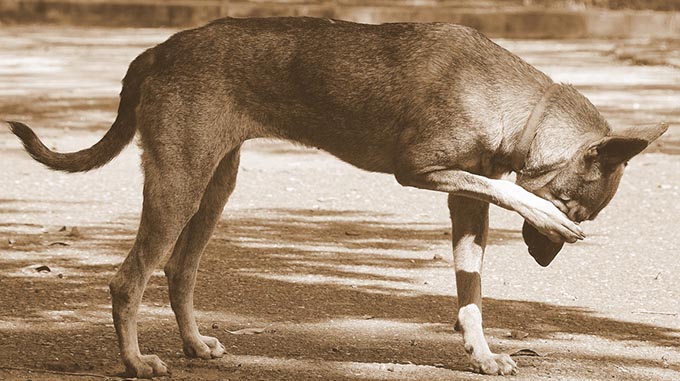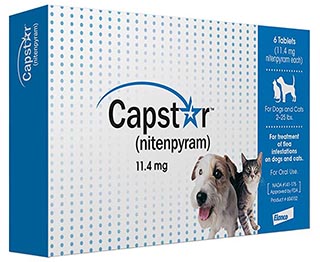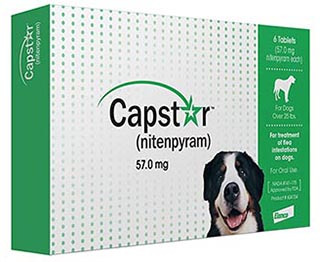Fleas are nasty little critters.
You want to rid your pet of them, fast.
The most effective step in eliminating fleas is an oral treatment to kill them off.
Capguard and Capstar are two popular flea pills. How do they work, and which is more effective?
Read on – I’ll help you get rid of fleas once and for all.
Capguard or Capstar?
For starters, let’s compare these two medications.
Capstar is the original, brand-name medication of the drug nitenpyram.
Capguard is considered a generic version.
Each brand comes in two different dose sizes. Here are the available versions:
| Name | Dosage | Used For |
| Capguard | 11.4 mg | Cats/Dogs 2-25 lb. |
| Capguard | 57 mg | Dogs over 25 lb. |
| Capstar | 11.4 mg | Cats/Dogs 2-25 lb. |
| Capstar | 57 mg | Dogs over 25 lb. |
Which should you go with?
I’d choose Capstar, the brand name.
Generic medications are required to have the same active ingredients, in an amount that’s within a certain range of the original. The use of a range means medications can vary slightly from the brand name.
Additionally, the fillers used in generics can be different. That could change how long it takes the medicine to be absorbed into the bloodstream.
In most cases, this won’t impact how effective a drug is. Generics are often much less expensive.
When comparing Capguard versus Capstar, though, the prices are very similar. They’re both just under $30 for 6 doses.
Since the prices are so close, I’d stick with Capstar.
Oral Treatments
To keep fleas from multiplying in your pet’s fur, you need to kill them off. All of ’em.
Oral flea meds work very quickly.
Capguard and Capstar start working within 30 minutes. By the 4-6 hour mark, over 90% of fleas are killed off.
While killing off the fleas is just the first step in keeping them from coming back, it’s the most important one.
It’s important to have a fast acting treatment to rid your dog or cat of them for good.
Over the Counter vs Prescription
If you suspect your pet has fleas, I recommend calling your vet as the first step.
In most cases they will have you bring your pet in for an evaluation. Then they’ll diagnose the problem and come up with a treatment and cleanup plan.
Chances are, your vet will recommend a prescription flea medication for your pet. A number of different options are available which can be tailored to how severe the flea infestation is. They also can be better matched to the weight of your dog or cat to ensure they get just enough of a dose to treat the problem.
If prescription meds are the first choice of vets, when is using an over-the-counter medication appropriate?
As mentioned earlier, Capguard and Capstar work very quickly.
If it will be a few days until you can get your pet in for a vet appointment, you may wish to treat the fleas immediately.
The fast response of OTC medications can help ease your pet’s discomfort and limit the spreading of fleas.

Making Sure Fleas Don’t Return
Using medication to get rid of the fleas on your pet is the first step.
To ensure they don’t return, you’ll also need to treat the areas your pet has been since the fleas hitched a ride.
This includes your pet’s bed and anywhere else they’ve walked or have been lying down.
If the area your pet was in was limited to a small space, use a flea spray.
If your pet has been throughout a large area, further treatment is a good idea.
First, use the flea spray on any areas you’ve spotted fleas or where you know your pet has spent some time.
Next, use a flea fogger.
Plan on using one canister in the center of each room that needs to be treated.
Be sure to follow the instructions of the fogger closely.
You’ll only need to be out of the house for a couple of hours before it’s safe to reenter.
If you’d rather not use a fogger, food-grade diatomaceous earth can be spread throughout the area instead. Once the powder has been left in place for 24 hours, it can be vacuumed up.
If your pet has been on top of bedding or other washable fabrics, wash them using hot water with soapy hot water.
If you’re not comfortable with the do-it-yourself methods above, I recommend contacting an exterminator.
The cost will be greater, but they have the experience and knowledge to make sure all fleas are completely eliminated.

Common Questions
How long do Capguard and Capstar last?
They are effective for 24 hours.
A box contains 6 doses. You can give your pet one pill each day.
Can puppies and kittens take these medications?
Yes – as long as they are at least 4 weeks old and weigh at least 2 pounds.
Be sure to go with the smaller 11.4mg dose for any pet under 25 pounds.
How do I get my pet to swallow an oral flea tablet?
If you have a fairly cooperative dog or cat, you may be able to get them to swallow the pill whole.
With one hand, hold the upper part of the jaw near the hinge. Tilt their head back. Gently open their lower jaw with your other hand. Place the pill as far back on the tongue as possible, then close their mouth.
If your dog or cat licks their chops after, they’ve most likely swallowed it. You can also check inside their mouth to be certain.
For our less cooperative canine and feline friends, the best way may be to get them to eat the medicine with a treat.
I’ve found that Pill Pockets work very well for both cats and dogs.
Alternatively, you can stuff the pill inside their favorite canned food, wrap it in cheese, or put it inside another soft food like tuna or cream cheese.
Conclusion
A vet’s treatment plan, plus an exterminator, will be the most effective.
If you need to treat fleas immediately with an over the counter product, the Capstar tablets linked below are my recommendation.
They’re fast acting, yet reasonably priced.
 |  |

